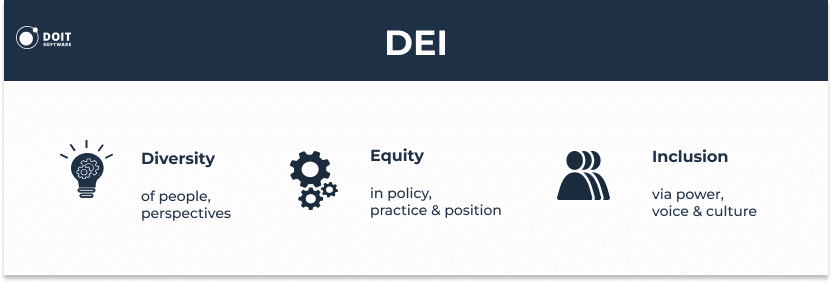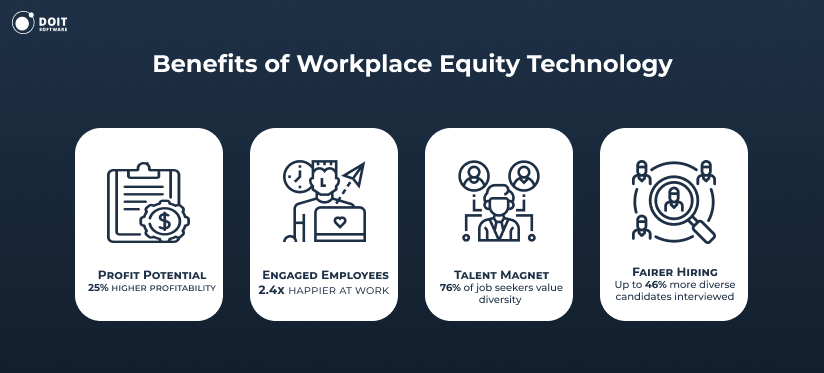Picture a workplace where innovation thrives and profits soar. That’s the power of equity in action. Indeed, inclusive companies are 1.7 times more likely to lead innovation in their markets. Also, organizations with diverse management teams report 35% higher innovation revenue.
Yet, despite these compelling numbers, several challenges continue to obstruct DEI progress in most organizations. These roadblocks include bias in recruitment processes, unequal opportunities in career development and performance evaluations, etc.
Workplace equity technology is emerging as a potential solution to these diversity issues. These tools promise to revolutionize hiring, promoting, and cultivating talent. But in a world where 24% of employees have faced workplace discrimination, can algorithms truly level the playing field?
Let’s explore how to implement equity and equality in the workplace by harnessing the power of diversity and technology.
DEI is about creating an environment that celebrates the unique attributes of each employee.

Let’s review some crucial numbers:
Despite the clear advantages, many companies still lag in DEI efforts. About 62% of organizations allocate limited or no resources to DEI. This gap presents both a hurdle and an opportunity for businesses to gain an edge.
Leadership commitment to DEI is growing but faces challenges. By 2022, most S&P 500 companies had a Chief Diversity Officer (CDO). However, the average CDO tenure has been shortened to less than two years. This factor suggests difficulties in implementing long-term DEI strategies. Platforms like Sintra offer innovative solutions to bridge this gap by leveraging technology to streamline and strengthen DEI initiatives.
Technology, however, is emerging as a powerful tool to address this issue. The DEI tech market is booming, now worth $5.3 billion. This growth is driving new ways to create fair workplaces. So, let’s explore how new workplace equity technology can boost DEI efforts.
Diversity and inclusion technology is designed to promote fairness. These tools can be categorized into several key types. Let’s explore some of these workplace equity technology examples.

This type of workplace equity platform removes personal information from candidate applications. Such workplace technology addresses unconscious bias in the hiring process by eliminating factors like:
Studies show that over 40% of women say they’ve faced unfair treatment at work. Anonymizing resumes could be a big step towards hiring based on skills, not gender.
Examples:
TalVista’s redacted resume screening tool removes personal details from applicant documents.
Pinpoint allows users to enable blind recruiting on a job-by-job basis, selecting which candidate details to anonymize at different interview stages.
Applied randomizes and anonymizes test answers for scoring to minimize bias among hiring managers.
These platforms shift the focus from traditional resume screening to evaluating candidates based on their skills. Doing so helps level the playing field for people from diverse backgrounds.
Examples:
Toggl Hire offers over 20,000 pre-made test questions to assess qualifications for different roles. It allows companies to create competency-based tests and set pass thresholds.
GapJumpers provides access to a database of skills assessment questions. Moreover, the software helps users create custom ones for different roles.
Pymetrics uses gamified behavioral assessments to produce personalized profiles highlighting candidates’ strengths and weaknesses.
These tools analyze job descriptions and other recruitment materials to identify potentially biased language. This technology helps create more inclusive job postings that attract diverse candidates.
Job posting language analyzers specifically check for gendered or exclusionary language. The impact of such tools can be significant; for instance, eBay saw a 40% increase in female applicants after changing phrases like “prior experience” to “demonstrated ability” in their job ads.
Examples:
TalVista’s job description optimizer flags non-inclusive language. It also coaches teams to avoid problematic phrasing, such as mentions of sexual orientation.
Such tools provide interview questions and guidelines to ensure a fair interview process. These platforms promote equitable candidate evaluation by reducing the potential for biased questioning.
Examples:
Applied provides a customizable test library, fair grading algorithms, and predictive candidate shortlisting.
These technologies track and analyze diversity metrics throughout the hiring process and within the organization. They measure ethnic & gender diversity, disability status, and other factors. By providing data-driven insights, these tools help companies identify areas for improvement.
Example:
Applied provides access to DEI analytics, allowing companies to track their diversity hiring efforts.
These tools use AI to find the best person for the job based on skills, not just past jobs or education. Plus, they can be particularly effective in matching candidates to remote work positions.
The system parses resumes and job descriptions using natural language processing, extracting and analyzing relevant skills and requirements. It then employs machine learning algorithms to perform semantic matching between candidate profiles and job needs. This process allows the AI to understand context and equivalencies between different skill descriptions. By focusing on capabilities, these AI solutions can discover great candidates who might otherwise be overlooked.
Example:
Pymetrics allows users to train custom AI algorithms to better identify applicants for internal mobility or upskilling opportunities.
These algorithms analyze various aspects of the hiring process to identify potential biases. They leverage statistical analysis to find differences in how groups are treated. The tools spot hidden biases in resume reviews and interviews. Then, they flag these issues, allowing companies to take corrective action.
Example:
IBM’s AI fairness tool checks for bias in ML models used in recruitment, helping to ensure that automated systems don’t perpetuate existing biases.
These solutions allow workers to report unfair treatment without sharing any personal information. They also help companies look into problems without revealing who reported them. By encouraging open communication, this tech helps organizations address problems quickly.
Example:
AllVoices is a digital platform that lets employees anonymously report workplace issues. It keeps users’ identities secret by using strong encryption and unique report IDs. The system allows companies to respond to reports without revealing who made them. It helps businesses address problems early and improve their work environment.
Workplace technology may foster a positive work environment and unlock substantial business advantages. So, without further ado, let’s go over them.
Workplace equity technology offers several key advantages for organizations:

Companies can build more diverse teams using tools that help identify and mitigate bias. It leads to a broader range of perspectives and ideas. Research shows that diverse companies are 35% more likely to outperform their competitors financially. Moreover, companies with high racial diversity bring in nearly 15 times more sales revenue than those with low racial diversity.
Technology can help remove human biases from hiring, promotions, and performance reviews. It creates fairer outcomes for all employees. For example, blind recruitment software has increased the likelihood of women and minorities advancing to the interview stages by 25-46%.
Workers who feel they’re being treated equitably tend to be more satisfied and productive. A study found that employees who feel valued are three times more likely to report feeling happy at work. Additionally, 83% of millennials report being actively engaged when their company fosters an inclusive work environment.
Companies that are committed to equity are often seen as more desirable workplaces. This aspect can give them an edge in attracting skilled candidates in competitive job markets. In fact, 76% of job seekers consider workplace diversity a critical factor when evaluating companies and job offers.
Gender-diverse companies are 25% more likely to experience above-average profitability. Furthermore, companies with ethnically diverse boards are 43% more likely to experience higher profits.
The implementation of equity technology enables more data-driven decision-making. For instance, analytics tools can help identify pay disparities or promotion gaps. As a result, companies can take targeted action to address inequities.
Equity technology can improve compliance with anti-discrimination laws and regulations. Automated systems create clear audit trails and documentation of fair practices, reducing legal risks.
Overall, workplace equity technology is a powerful tool for creating a more inclusive and engaged environment. By reducing and creating equal opportunities, this tech helps companies unlock the full potential of their entire workforce.
The potential of technological advancements in the workplace to create a more equitable environment is undeniable. Nevertheless, it’s crucial to approach their integration thoughtfully.

Here are some additional considerations:
The algorithms learn from training data, which can perpetuate existing biases. For example, Amazon encountered issues with a hiring algorithm that favored male candidates.
The example highlights the importance of carefully auditing workplace equity technology for potential biases. Organizations need to ensure their data sets are diverse and representative.
While technology can process large amounts of data efficiently, human oversight remains crucial. DEI platforms might see patterns in performance reviews. However, people are needed to interpret results, consider context, and make ethical decisions.
Companies should establish clear protocols for reviewing workplace technology recommendations. This approach helps balance the efficiency of these tools with the nuanced understanding that humans can provide.
Constant monitoring could stress employees and harm morale. There’s a risk of oversimplifying complex workplace dynamics, potentially leading to misguided decisions.
Workplace equity technology could unintentionally create new inequalities, favoring those who understand how to “perform” for these systems. Consequently, employees might become less creative or risk-averse if they feel constantly evaluated.
Organizations can consider a balanced approach when implementing workplace equity technology. It may involve providing transparency about the technology’s usage and ensuring ethical and limited monitoring practices. Regular feedback sessions could foster understanding and trust among employees. Comprehensive ethical training programs might help all staff become proficient with the new systems. Promoting open communication and continuous improvement could contribute to a positive work environment.
Workplace equity technology often requires access to sensitive personal information. This factor raises significant data privacy and security concerns. Organizations must implement robust protection measures and ensure compliance with relevant regulations.
Clear policies on data usage, and storage are essential. Employees should be informed about what information is being collected and how it will be used. Companies also need to address any concerns employees may have about data privacy.
Regular audits are necessary to identify and address any emerging issues. Companies should perform quantitative data analysis to overview the impact of such technology in the workplace. Businesses should also set up feedback loops where employees provide input on their experiences with the DEI platform.
Diverse development teams can also help bring different perspectives to implementing these systems. They can identify potential blind spots and biases that a more homogenous group might overlook.
As we’ve explored, workplace equity technology presents both opportunities and challenges for organizations. These digital tools offer a path to reducing bias, increasing diversity, and fostering a sense of belonging among employees. However, their adoption is not without complexities.
A thoughtful and strategic approach is critical for companies implementing workplace equity technology. It is particularly important given that 62% of companies still allocate limited or no resources to DEI efforts. A comprehensive strategy might involve:
Ultimately, workplace equity technology is not a silver bullet for solving all diversity and inclusion issues. However, these tools can create fairer workplaces when implemented thoughtfully and as part of a comprehensive DEI strategy.
Collaborating with experienced IT professionals can be valuable for organizations looking to develop tailored equity software. If you’re interested in partnering with top-tier developers, contact us and get your first CVs within a few days.
Tools like blind recruitment, skills assessments, and AI language analysis can reduce bias in hiring and job postings.
Equity means creating a fair and level playing field for all employees, regardless of background.
There are tools for anonymized resumes, skills-based testing, unbiased job postings, structured interviews, diversity data tracking, and more.










